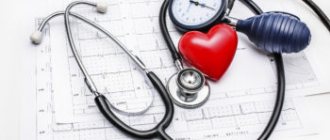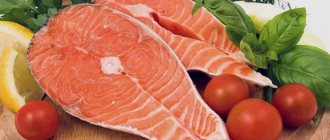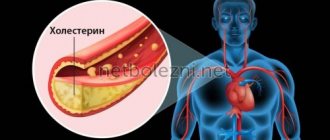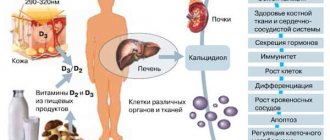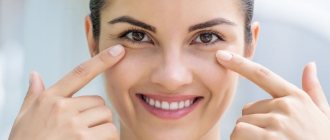The popular belief that cholesterol is harmful to health is not entirely true. On the contrary, it is necessary to ensure some vital processes in the body.
Only about 20% of this substance comes with food, and 80% is synthesized by the liver. Of interest is the opinion of the famous doctor and host of the popular medical program Dr. Myasnikov about cholesterol and statins. It is known that he himself has been taking these drugs for a long time to prevent atherosclerosis.
Mechanism of action of statins
Statins block the enzyme HMG-CoA reductase, which triggers sterol synthesis.
Therefore, another name for the drugs is HMG-CoA reductase inhibitors. Reducing the amount of synthesized cholesterol forces the body to look for alternative sources of its production. The simplest of them is the absorption of sterol from food. Therefore, during treatment, the patient must adhere to a diet that limits the intake of cholesterol into the body. Otherwise, the need to launch other compensatory mechanisms disappears.
The second most difficult is the breakdown of LDL. Under the influence of statins, receptors on the surface of the liver are activated that capture LDL and extract cholesterol. The second source of sterol production is atherosclerotic plaques, tissues containing it. To deliver cholesterol to the liver, additional amounts of HDL are synthesized.
Reducing the level of cholesterol, LDL, triglycerides, increasing the content of HDL inhibits the progression of atherosclerosis. Consequently, the likelihood of developing complications that it provokes is reduced: coronary heart disease, stroke, myocardial infarction, limb necrosis.
The benefits of statins are not limited to their effect on lipid metabolism. Taking them improves the condition of the vessel wall, reduces blood viscosity, and helps relax the muscular lining of the artery.
The harm of statins is not denied by drug manufacturers and health authorities. But its reasons are unclear. There are several theories to explain the side effects of medications:
- disruption of the oxidation of fatty acids;
- mitochondrial dysfunction;
- autoimmune reactions;
- damage to cell membranes (this includes cholesterol);
- activation of pathological processes to which a person is predisposed;
- reduction in coenzyme Q10 content.
Statins - what are these drugs?
Statins belong to the group of lipid-lowering drugs - drugs that reduce the concentration of various fractions of lipids (fats) in the tissues and organs of the human body. The benefits and harms of statin treatment for high cholesterol are still a matter of debate in scientific medical communities, since there is not a sufficient evidence base to allow us to declare with 100% confidence the high effectiveness of these drugs in the prevention of atherosclerosis and coronary disease.
Beneficial properties and mechanism of action of statins
The bioavailability of most drugs in this group is no more than 20%, and the maximum concentration in the blood plasma is achieved 5 hours after administration. The connection with albumin and other plasma proteins is at least 90%.
- The therapeutic effect of statins is due to the pharmacological properties of these drugs, which include:
- selective inhibition of HMG-CoA reductase, an enzyme that synthesizes mevalonic acid, from which cholesterol crystals are formed;
- an increase in the number of liver receptors for low molecular weight lipoproteins;
- reduction of plasma levels of cholesterol and triglycerides while simultaneously stimulating the formation of high molecular weight (“good”) cholesterol.
One of the beneficial properties of statins is also considered to have a positive effect on the functioning of the heart. According to statistics, in half of the patients receiving statin therapy, the size of the heart muscle corresponded to physiological norms, which is an indicator of increased resistance to stress factors and manifestations of myopia.
The maximum therapeutic result is observed by the end of the fourth week of treatment. Statins are considered an effective treatment for hyperlipidemia only in people of the middle age group (up to 50 years). In senile and elderly patients, diet therapy plays a leading role in the prevention of atherosclerosis.
general information
Drugs from the statin group appeared due to the fact that the entire scientific world is struggling with high levels of cholesterol in the blood. Most people are sure: if their cholesterol has increased, this means that after some time atherosclerotic plaques must form. This is not an entirely correct opinion.
It should be noted that cholesterol level and the number of plaques in the blood are two completely non-linear relationships. Dr. Shishonin notes that there is no need to be afraid of cholesterol. In the video “Secrets of Treatment of Atherosclerosis,” the author reveals the whole truth about cholesterol.
Additionally, if you become a member
"Club of former hypertensive patients"
, you can find a lot of other interesting and, most importantly, healthy information. User registration is completely free.
To reduce blood cholesterol, it is customary to prescribe statins in medicine. What is their mechanism of action and are they harmful to health? Answers to these and other questions will be presented below.
So, cholesterol is a fat that is synthesized in all cells of our body, but the factory for the production of this substance is located in the liver. Cholesterol is used by the body to build cell membranes, for the biosynthesis of bile, group D vitamins and steroid hormones (androsterone, androstenedione, dehydrotestosterone, estradiol, estrone, estriol, etc.).
Taking into account the mechanism of cholesterol formation, scientists (pharmacologists, biochemists) decided to influence liver cells so that they stop synthesizing huge amounts of this substance. They started using statins to reduce cholesterol production. These medications break the metabolic chain of formation of this substance. All this negatively affects the functioning of the liver.
Drugs that should not be combined with statins
- The risk of developing a syndrome characterized by extreme myopathy increases several times if the patient takes statins simultaneously with the following medications:
- antimycotics in the form of aerosols;
- antibacterial drugs from the macrolide group (azithromycin, clarithromycin, erythromycin);
- fibric acid derivatives (fibrates);
- some immunosuppressants (eg, cyclosporine);
- Verapamil;
- preparations of nicotinic acid and its derivatives.
The risk of complications also increases in patients who suffer from alcohol dependence, adhere to a low-calorie diet, or have a history of severe liver pathologies. If the patient has undergone surgical treatment, statins should be discontinued.
It is forbidden to take any statins with grapefruit juice.
Indications for prescribing statins
The benefits of statins have been proven for patients who do not respond to diet therapy for:
- familial homo-, heterozygous hypercholesterolemia;
- combined hypercholesterolemia;
- dysbetalipoproteinemia;
- hypertriglyceridemia.
Certain drugs in the group are indicated for children with hereditary homozygous hypercholesterolemia. This is a severe genetic abnormality in which cholesterol levels are high regardless of diet. Patients with homozygous hypercholesterolemia are at risk of developing very early coronary heart disease and myocardial infarction.
Taking statins is harmful to the body if the drug is prescribed to people who do not need it. There is no doubt that medications are really effective in preventing complications of atherosclerosis and recurrent heart attack/stroke. What is fundamentally controversial is not the prescription of statins, but the patient selection criteria and dosage. Lists of recommendations are regularly reviewed and adjusted in accordance with new research results.
Statins are indicated for people:
- having cardiovascular diseases;
- LDL level above 190 mg/dl;
- people 40-75 years old with type 2 diabetes mellitus;
- people 40-75 years old with ≥7.5% 10-year risk of developing cardiovascular disease.
When calculating the risk of cardiovascular diseases, the following are taken into account:
- floor;
- age;
- race;
- total cholesterol level, LDL;
- systolic pressure indicators;
- whether the patient is taking medications to lower blood pressure;
- presence of diabetes;
- whether the person smokes or not.
Statins:
- taken exclusively in conjunction with diet;
- require compliance with the dosage regimen;
- accompanied by regular blood tests;
- are appointed for life. The effectiveness of statin therapy courses has not been proven.
Statins, list of drugs for the treatment of high cholesterol
Indications for the prescription of statins are diseases and pathologies associated with increased deposition of cholesterol crystals and the formation of cholesterol plaques. This is not only atherosclerosis, but also heart disease (heart attack, coronary artery disease, hypertension), as well as an increased risk of blockage of blood vessels during cerebral stroke. In some cases, short courses of statins can be prescribed to correct lipid metabolism in persons with bad habits (in particular, smoking) or who are obese.
- List of drugs from the statin group, as well as a brief overview and approximate cost:
- Rosuvastatin (300-650 rubles). The active ingredient is rosuvastatin calcium. The drug is prescribed in a dosage of 20-40 mg 1 time per day. If the patient is receiving rosuvastatin therapy for the first time, it is necessary to start with the minimum effective dosage (no more than 20 mg). Analogues: Rosucard, Suvardio, Roxera.
- Simvastatin (30-120 rubles). It is prescribed once a day at a dosage of 10-20 mg in the evening. The interval between taking the drug and eating should be at least 2 hours. Analogues: Vazilip, Simvor, Simvastol.
- Lovastatin (240 rubles). The use of Lovatstein requires adjustment of the dosage regimen once every 4 weeks. The maximum daily dosage is 80 mg (in two doses). Take with meals. Analogues: Medostatin, Cardiostatin.
- Leskol (2560-3200 rubles). The active ingredient is fluvastatin sodium. Used primarily for the treatment of unspecified hyperlipidemia. Take at a dosage of 40-80 mg per day.
- Atorvastatin (170-210 rubles). Take at any time of the day, regardless of meals. Daily dosage – from 10 to 80 mg. Analogs: Atoris, Liprimar, Anvistat.
- Lipobay (310 rubles). The active ingredient is cerivastatin sodium. Take orally 1 time per day at a dosage of 20-40 mg (but not more than 80 mg).
While using some statins, the patient may experience joint pain, painful abdominal cramps, and respiratory side effects (runny nose, cough). The risk of undesirable consequences during treatment with statins increases if they are taken simultaneously with drugs that inhibit the lipid-lowering properties of these drugs.
The harm of statins
Why are statins dangerous? Like most drugs, drugs in this group have a number of side effects and contraindications for use. Most are mild and can be lived with given the potential benefits. The danger is that severe adverse reactions often develop after years of taking the drugs.
The frequency of side effects indicated in the instructions differs to a lesser extent from the number of real complaints. The reason for the discrepancy is the careful selection of patients for the clinical trial. Typically, people with kidney failure, liver failure, a history of myalgia, severe diabetes mellitus, and taking medications that can interact with HMG-CoA reductase inhibitors are excluded from it.
The most common harmful side effects of statins are muscle problems. The reason for their occurrence is unknown. A pattern has been identified between intense physical activity and serious muscle complications. About 25% of athletes taking statins report muscle pain and spasms.
The most common adverse reaction is myalgia (muscle pain). It affects 5-7% of patients.
Myopathy is a fairly rare complication of statins. It develops in 5 people out of 100,000. The severity of myopathy varies: from increased creatine kinase activity with or without myalgia, weakness to muscle breakdown (rhabdomyolysis). Cases of the latter are fortunately rare - 0.44-0.54 cases/10,000 people per year.
The harm of statins to the digestive system is negligible. Taking most medications is accompanied by flatulence, gastrointestinal discomfort, constipation and/or diarrhea.
Taking statins is often accompanied by an increase in the level of liver amylases: ALT, AST. High activity of these enzymes is associated with liver damage. But in fact, they speak of hepatotoxicity when 3 factors coincide:
- increase in ALT, AST ≥3 times;
- increased concentration of total bilirubin (≥ 2 times);
- there are no other causes of changes in blood biochemistry (cholestasis, infectious hepatitis, taking a drug toxic to the liver).
An isolated increase in the enzyme is characteristic of several diseases. They must be excluded before drawing conclusions about the medicinal nature of the pathology.
The harmful effects of statins on the fetus were tested in laboratory animals. Rats whose mothers were given HMG-CoA reductase inhibitors were born with developmental defects, which is predictable. Cholesterol is necessary for the normal formation of the fetus. The body of pregnant women even produces an increased amount of it. Blocking cholesterol synthesis disrupts embryo development.
No studies have been conducted on the effects of statins on the human fetus due to the large number of risks to the health of the unborn baby. Based on theoretical assumptions and experiments involving animals, the use of statins by pregnant women was prohibited.
When prescribing a drug to a woman of childbearing age, a doctor warns her about the need to use reliable contraceptives. An unplanned pregnancy will present her with a difficult choice: leave the baby, accepting possible pathologies, or have an abortion.
The harm caused by statins to the nervous system is widely discussed in the medical community. Indeed, while taking statins, memory impairment, peripheral neuropathy, depression, sensitivity, and sleep may develop.
When a possible relationship between drug use, amnesia, and dementia was discovered, this phenomenon began to be studied. The results obtained are quite controversial. There is a lot of data proving that statins reduce the risk of developing dementia, and taking them together with some antidepressant drugs allows you to overcome depression much faster.
The harm of statins has been proven in relation to the development of type 2 diabetes.
In addition to cholesterol synthesis, statins block the formation of coenzyme Q10. A lack of coenzyme leads to a deficiency of energy storage molecules. To provide the body with energy, the breakdown of additional glucose molecules is triggered. Sugar catabolism is carried out by the enzyme insulin, which begins to be synthesized in large quantities. Its consistently high concentration is addictive. Cells stop responding to it and assimilate glucose normally.
True, diabetes mellitus threatens those who have a predisposition to it:
- glucose level more than 5.6 mmol/l;
- BMI more than 30 kg/m2;
- triglyceridemia;
- hypertension.
Despite the possibility of developing diabetes mellitus, the benefits of taking statins outweigh the harms. Studies have shown that treating 250 people with statins for 4 years will provoke diabetes in one. At the same time, the use of drugs will prevent 5.4 deaths/250 people.
Other complications
During treatment with statins, vision may deteriorate. The most common complication is nebula, less often - bifurcation, cataract.
A hypothesis has also been put forward about the relationship between statin use and the development of cancer. It has been suggested that low cholesterol levels increase the risk of developing cancer. But this theory has not found sufficient evidence. On the contrary, data have emerged on the ability of statins to reduce the risk of developing prostate, stomach, and colon cancer.
The negative impact of statins on male sexual function is controversial. In a few patients, potency decreased during treatment. This may be due to general weakness and fatigue, which is accompanied by taking medications. However, some patients, on the contrary, note an improvement in erection since the start of treatment, which can be explained by an improvement in the condition of the blood vessels.
With long-term use of statins, side effects may occur:
- increased fatigue;
- muscle pain;
- dizziness;
- dysfunction of the digestive system;
- nausea and vomiting;
- rhabdomyolysis (destruction of muscle fibers);
- hyperglycemia;
- multiple sclerosis;
- vascular thrombosis;
- chills;
- myopathy;
- arthralgia;
- cataract;
- Alzheimer's disease;
- peripheral edema;
- jaundice;
- anorexia;
- pancreatitis;
- renal failure;
- skin rashes;
- persistent insomnia;
- flatulence;
- skin aging;
- blood clotting disorder;
- erectile disfunction;
- obesity;
- problems with memory and thinking;
- reactive cirrhosis.
Note. Dr. Shishonin notes that statins are a metabolic poison for the liver. Drugs from this pharmaceutical group, by interfering with deep biochemical processes, block natural reactions occurring in the liver. If these processes are disrupted, the physiological functions of the organ will not be restored soon. If possible, do not use statins, avoid them. Replace them with other substances, lead an active lifestyle.
Benefits of statins
Statins are considered very effective and relatively safe drugs. Their effect on the body has been studied much more fully than other drugs. The benefits that statins provide are difficult to overestimate. Medicines in this group:
- lower cholesterol levels - 23-42%, LDL 20-55%, triglycerides 5-10% or 15-30% (depending on the active substance), increase HDL concentration - 10-20%;
- reduce mortality – 17%;
- reduce the likelihood of cardiovascular deposits - 24%, myocardial infarction - 53%, stroke - 48%.
However, they should be prescribed with caution as they significantly alter metabolism.
What can replace statins and is there an alternative to them?
First you just need to stop taking them. Naturally, this must be done only under the supervision of the attending physician. It is necessary to gradually reduce the dose, as some drugs can be addictive. After determining the level of cholesterol in the blood, you can begin diet therapy.
With an irrational diet, the level of cholesterol in the blood will not normalize. If a person’s cholesterol increases when they stop taking statins, then this is not bad. If the patient adheres to the doctor’s recommendations, then after some time the level of this compound will stabilize.
To normalize blood cholesterol levels, you need to do physical exercise. You can start with squats. If you do them regularly, at least 50-60 times a day, you will achieve the desired result. Specialists at Doctor Shishonin’s Clinic point out that this method always works flawlessly.
Why does squatting lower cholesterol? The answer is simple. During squats, the most powerful muscles in our body work. To perform this work, the body must synthesize new muscle fibers, and for this it will need a lot of cholesterol, which is spent on building cellular biomembranes.
Elena Malysheva
Elena Malysheva is a Russian TV presenter of the “Health” and “Live Healthy” programs. She worked as a therapist for some time and defended her dissertation on cardiac arrhythmias. She was not a practicing doctor for long and after several years of work she became an assistant at the Department of Internal Medicine of the Russian State Medical University, where she still lectures from time to time.
The program “Live Healthy,” which airs on Channel One, has brought scandalous fame to the presenter, as frank topics are discussed on the morning broadcast.
Nutrition secrets
It is important that your diet contains high-quality fats. What is it for? First of all, this is necessary so that bile, which consists mainly of cholesterol, enters the duodenum through the ducts. Without bile, the process of emulsification and breakdown of fats will not occur.
If a person does not consume fats, then he will soon have problems with the functioning of the gallbladder and liver. This is discussed in Dr. Shishonin’s video “The Secret is in the Word Cholesterol.”
When eating fatty foods, bile flows into the duodenum. In this part of the intestine there are receptors that, when fatty foods enter, are excited, and the liver and bile ducts are stimulated, they contract, which leads to secretions entering the intestines.
Thus, the liver gets rid of accumulated cholesterol, sending it to the intestines. This is a very important physiological process that must be carried out daily. Eating high-quality dairy products (sour cream, cheese, cottage cheese, etc.) helps reduce cholesterol.
Doctor Myasnikov about cholesterol and statins
Cholesterol is solid bile or lipophilic alcohol. The organic compound is an integral part of cell membranes, which makes them more resistant to temperature changes. Without cholesterol, the production of vitamin D, bile acids and adrenal hormones is impossible
The human body produces approximately 80% of the substance itself, mainly in the liver. The remaining 20% of cholesterol comes from food.
Cholesterol can be good and bad. The chief physician of City Clinical Hospital N°71, Alexander Myasnikov, draws the attention of his patients to the fact that the beneficial or negative effect of a substance on the body depends on the density of the lipoproteins that make up the organic compound.
In a healthy person, the ratio of LDL to LDL should be equal. But if the levels of low-density lipoproteins are too high, then the latter begin to settle on the walls of blood vessels, leading to adverse consequences.
Doctor Myasnikov claims that levels of bad cholesterol will increase especially rapidly if the following risk factors are present:
- diabetes;
- hypertension;
- overweight;
- smoking;
- IHD;
- poor nutrition;
- vascular atherosclerosis.
Consequently, the primary cause of strokes and heart attacks around the world is an increase in the level of bad cholesterol in the blood. LDL is deposited on blood vessels, forming atherosclerotic plaques, which contribute to the formation of blood clots, which often leads to death.
Myasnikov also talks about cholesterol for women, that it is especially harmful after menopause. After all, before the onset of menopause, the intensive production of sex hormones protects the body from the appearance of atherosclerosis.
If cholesterol levels are high and the risks are low, drug treatment is not prescribed.
Statins are a leading group of drugs that help reduce harmful cholesterol to acceptable levels. These drugs significantly reduce the risk of developing cardiovascular diseases, although Dr. Myasnikov emphasizes to patients that medicine still does not know the exact principle of their action.
The scientific name of statins is HMG-CoA reductase inhibitors. They are a new group of drugs that can quickly lower LDL levels and increase life expectancy.
Presumably, the statin slows down the function of the liver enzyme that synthesizes cholesterol. The drug increases the number of LDL apolyprotein and HDL receptors in cells. Thanks to this, harmful cholesterol lags behind the vascular walls and is utilized.
Dr. Myasnikov knows quite a bit about cholesterol and statins, since he himself has been taking them for many years. The doctor claims that in addition to their lipid-lowering effect, liver enzyme inhibitors are highly valued due to their positive effects on blood vessels:
- stabilize plaques, reducing the risk of their rupture;
- eliminate inflammation in the arteries;
- have an anti-ischemic effect;
- improve fibirinolysis;
- strengthen the vascular epithelium;
- have an antiplatelet effect.
In addition to reducing the likelihood of developing diseases of the cardiovascular system, the benefit of statins is to prevent the occurrence of osteoporosis and intestinal cancer. HMG-CoA reductase inhibitors prevent the formation of gallstones and normalize kidney function.
Doctor Myasnikov draws attention to the fact that statins are very useful for men. The drugs help with erectile dysfunction.
All statins are available in tablet form. They are taken once a day before bedtime.
But before taking statins, you should take urine and blood tests and do a lipid profile to detect disorders in fat metabolism. In severe forms of hypercholesterolemia, you will need to take statins for several years or throughout your life.
| Generation | Features of the drugs | Popular products from this group |
| I | Made from penicillin mushrooms. Reduce LDL by 25-30%. They have a significant number of side effects. | Lipostat, Simvastatin, Lovastatin |
| II | Inhibits the process of enzyme release. Reduce total cholesterol concentration by 30-40%, can increase HDL by 20% | Leskol, Fluvastatin |
| III | Synthetic drugs are highly effective. Reduce total cholesterol by 47%, increase HDL levels by 15% | Novostat, Liprimar, Torvacard, Atoris |
| IV | Synthetic statins of the latest generation. Reduces bad cholesterol levels by 55%. Have a small number of adverse reactions | Rosuvastatin |
Despite the high effectiveness of statins for hypercholesterolemia, Dr. Myasnikov points out the likelihood of developing negative consequences after taking them. First of all, medications negatively affect the liver. Also, liver enzyme inhibitors in 10% of cases can affect the muscular system, sometimes contributing to the appearance of myositis.
There is an opinion that statins increase the risk of type 2 diabetes. However, Myasnikov is convinced that if you take the tablets in an average dosage, your glucose levels will rise only slightly. Moreover, for diabetics, vascular atherosclerosis, which leads to heart attacks and strokes, is much more dangerous than a minor disturbance in carbohydrate metabolism.
A number of studies have shown that in some cases statins impair memory and can change human behavior. Therefore, if such adverse reactions occur after taking statins, you should contact your doctor, who will adjust the dosage or discontinue use of the drug.
Taking statins brings both harm and benefit to the patient. These are serious drugs that require justified prescription. The risks of taking medications are much less than the potential benefits. This is confirmed by research results. While taking statins:
- the risk of heart attack and stroke is reduced by 50%;
- the number of patients requiring vascular operations is reduced;
- the risk of developing venous thrombosis is reduced by 15-25%;
- in patients with chronic obstructive pulmonary disease, mortality, the number of exacerbations, and hospitalizations are reduced;
- rosuvastatin reduces the likelihood of contrast-induced nephropathy in diabetes mellitus and chronic renal failure. This drug accelerates recovery from traumatic brain injuries.
You can watch a short video by Dr. Myasnikov, “Statins for cholesterol: harm and benefit,” in which the specialist explains the basic concepts very clearly.
Reviews
Marina Rybnikova, Nizhny Novgorod:
“Simvastatin is a very cheap and good cholesterol pill. They practically do not cause side effects and are sold in any pharmacy. My mother is 54 years old and took them for three months. Every 4 weeks I had blood and urine tests - everything was fine.”
Igor Permilovsky, Moscow:
“I was also prescribed statins when the test results revealed high cholesterol. I took the drug Rosuvastatin. I’m happy with the result: my cholesterol has dropped, and my weight has even decreased a little.”
Anna Vyacheslavovna, Kolomna:
“And I am against statins. There is such a large list of side effects and possible complications that you inevitably begin to doubt whether the benefits of their use outweigh. It’s more effective and safer to eat right and not exceed your fat intake.”
Statins are the main group of drugs used to treat hypercholesterolemia. Experts consider these medications to be quite effective for high cholesterol, but treatment with statins requires careful monitoring of biochemical parameters of blood and urine due to possible complications. You can take drugs from this pharmacological group only as prescribed by a doctor.
Author of the article: Sergey Vladimirovich, a supporter of reasonable biohacking and an opponent of modern diets and quick weight loss. I’ll tell you how a man aged 50+ can stay fashionable, handsome and healthy, and how to feel like 30 in his fifties. Read more about the author.
“Natural” analogues of statins
Natural statins are foods and herbs that contain substances that help lower sterol. By their nature, they are not HMG-CoA reductase inhibitors, but have similar properties. The only exception is red yeast rice. It contains lovastatin. If you are taking statins, eliminate this product from your diet. An overdose of statins is fraught with complications.
The following will help prevent the development of atherosclerosis, as well as slow its progression:
- cocoa;
- turmeric, basil, ginger, rosemary;
- oat bran;
- Cod liver;
- fish fat;
- flax seeds;
- Black tea;
- garlic;
- barley.
Herbal teas that help lower cholesterol:
- calendula;
- viburnum;
- alfalfa;
- raspberries;
- dandelion;
- licorice;
- linden color;
- thyme;
- rose hip;
- hawthorn berries.
There is a myth that naturally occurring statins do no harm. In fact, the therapeutic effect of plants is due to biologically active substances that require limited use and have side effects and contraindications. They may also interact with medications the patient is taking. Therefore, it is advisable to coordinate herbal treatment with your doctor.
